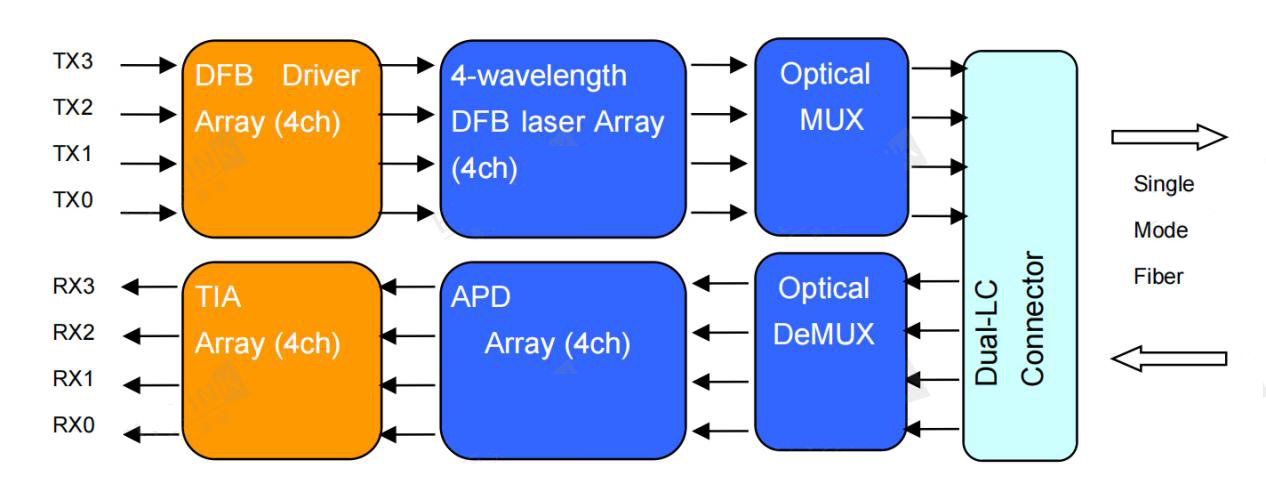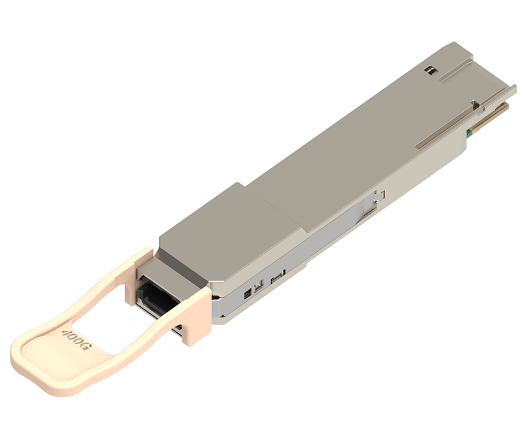The 40G QSFP+ ER4 optical module utilizes CWDM transmission technology, typically used with LC duplex connectors. It achieves a maximum transmission distance of up to 40KM over single-mode fiber (SMF) and supports DDM functionality. The 40G QSFP+ ER4 optical module converts the input channels of four 10G data into four CWDM optical signal channels. Each channel has a data rate of up to 11.2Gbps, and they are multiplexed into a single channel.
The QSFP+ module is crafted for 40GBASE Ethernet applications, supporting throughput up to 40km over single-mode fiber (SMF) using a 1310nm wavelength and duplex LC connectors. This transceiver complies with QSFP+ MSA, IEEE 802.3bm 40GBASE-ER4, and OTU3 standards. It incorporates digital diagnostic functions accessible through the I2C interface, as specified by the QSFP+ MSA, providing real-time access to operational parameters. With its user-friendly features, easy installation, and hot-swappable design, this transceiver is well-suited for diverse applications, including data centers, high-performance computing networks, and enterprise core and distribution layer setups.
目录
Toggle40G QSFP+ ER4 Specifications
| Product Model | QSFPP-40G-ER4 | Vendor Name | Walsun |
| Form Factor | QSFP+ | Max Data Rate | 40Gbps |
| Wavelength | 1271nm, 1291nm 1311nm, 1331nm |
Max Distance | 40km |
| Connector | LC Duplex | Transmitter Type | 4 Lanes CWDM DFB |
| Cable Type | SMF | Receiver Type | APD |
| TX Power | -3.7~+4.5dBm | Receiver Sensitivity | < -22dBm |
| Protocols | OTN OTU3, 40G Ethernet, Infiniband, Fiber Channel, SATA/SAS3, MSA Compliant | Operation Temperature | 0 to 70°C (32 to 158°F) |
Analysis of the working principle of 40G QSFP+ ER4 optical module
The 40G QSFP+ ER4 optical module is a transceiver module designed for long distance optical communication applications. The design conforms to 40GBASE-ER4 standard in IEEE 802.3ba standard. The module converts four 10Gb/s electrical signals into four CWDM optical signals and multiplexes them into one 40Gb/s optical transmission. Instead, at the receiving end, the module photodemultiplexes the 40Gb/s input into four CWDM channel signals and converts them into four channel output electrical signals.
Figure 1: 40Gb/s QSFP ER4 Transceiver Block Diagram
The central wavelengths of the four CWDM channels are 1271nm, 1291nm, 1311nm and 1331nm, which are members of the CWDM wavelength grid defined in ITU-TG694.2. It contains a duplex LC connector for the optical interface and a connector for the 148-pin electrical interface. In order to reduce light dispersion in long-distance systems, the module must use single-mode fiber (SMF).
The 40G QSFP+ ER4 optical module is designed according to the QSFP Multi-Source Protocol (MSA) and has a form factor, optical/electrical connection, and digital diagnostic interface. It is designed to meet the harshest external operating conditions, including temperature, humidity and electromagnetic interference.
Technical Considerations and Deployment Tips
When deploying the 40G QSFP+ ER4 optical module in data centers or other network environments, there are several technical considerations and best practices to ensure optimal performance and reliability.
Fiber Optic Cable Selection
- Single-Mode Fiber (SMF): The 40G QSFP+ ER4 module is designed for use with single-mode fiber, which is essential for achieving the extended reach of up to 40 kilometers. Ensure that high-quality single-mode fiber cables are used to minimize signal loss and maximize transmission distance.
- Connector Types: The module typically uses LC connectors, which provide a secure and reliable connection. Ensure that the fiber optic cables and connectors are clean and properly aligned to prevent signal degradation.
Network Design
- Link Budget: Calculate the link budget, which accounts for the total losses in the optical link, including fiber attenuation, connector losses, and any additional components such as optical amplifiers or splitters. Ensure that the link budget is within the acceptable range for the 40G QSFP+ ER4 module.
- Redundancy: Implement redundancy in the network design to ensure high availability and reliability. This can include using multiple 40G links and deploying redundant paths to prevent single points of failure.
Environmental Considerations
- Temperature and Humidity: The 40G QSFP+ ER4 module is designed to operate within specific temperature and humidity ranges. Ensure that the data center environment is controlled and within the specified operating conditions to maintain optimal performance.
- Cooling: Proper cooling is essential to prevent overheating and ensure the longevity of the optical module. Use adequate cooling systems, such as fans and heat sinks, to dissipate heat effectively.
Monitoring and Maintenance
- Digital Diagnostics Monitoring (DDM): Utilize the DDM features of the 40G QSFP+ ER4 module to monitor key parameters such as temperature, voltage, and signal strength. This allows for proactive maintenance and early detection of potential issues.
- Regular Inspections: Perform regular inspections and maintenance of the fiber optic cables and connectors. Clean the connectors regularly to prevent dust and dirt from affecting signal quality.
Future Trends and Innovations
As the demand for higher bandwidth and more efficient data center solutions continues to grow, the optical module industry is constantly evolving. Here are some future trends and innovations that may impact the deployment and capabilities of 40G QSFP+ ER4 optical modules:
Higher Speed Modules
- 100G and Beyond: While the 40G QSFP+ ER4 module provides significant performance improvements over previous generations, the industry is moving towards even higher-speed modules such as 100G, 200G, and 400G. These modules offer greater bandwidth and can support more demanding applications.
- Advanced Modulation Techniques: Future optical modules may use advanced modulation techniques, such as PAM4 (Pulse Amplitude Modulation), to increase data rates and improve spectral efficiency.
Integration and Miniaturization
- Integrated Optics: The integration of optical components into smaller, more compact modules can reduce power consumption and improve performance. This trend towards integrated optics may lead to more efficient and cost-effective solutions for data centers.
- Silicon Photonics: Silicon photonics technology, which integrates optical and electronic components on a single silicon chip, has the potential to revolutionize the optical module industry. This technology can enable higher data rates, lower power consumption, and reduced costs.
Automation and AI
- Automated Network Management: The use of automation and artificial intelligence (AI) in network management can improve the efficiency and reliability of data center operations. Automated systems can monitor network performance, detect anomalies, and optimize configurations in real-time.
- Predictive Maintenance: AI-powered predictive maintenance can analyze data from the DDM features of optical modules to predict potential failures and schedule maintenance before issues arise.
Conclusion
The 40G QSFP+ ER4 optical module is a powerful and versatile solution for modern data centers and other high-bandwidth applications. Its high data rate, extended reach, and energy efficiency make it an ideal choice for various usage scenarios, including data center interconnects, high-performance computing, enterprise networks, cloud computing, telecommunications, and broadcast and media.



